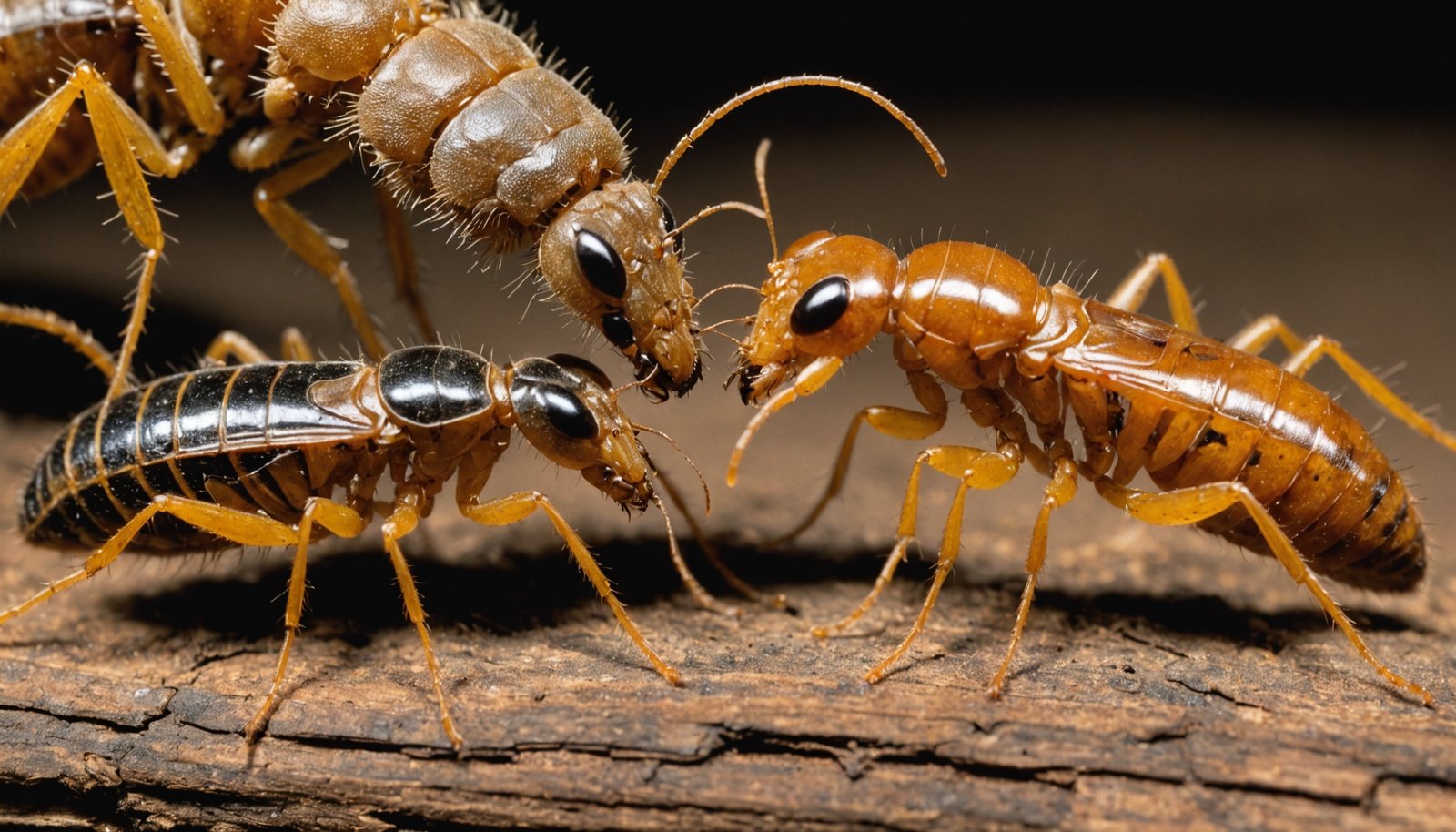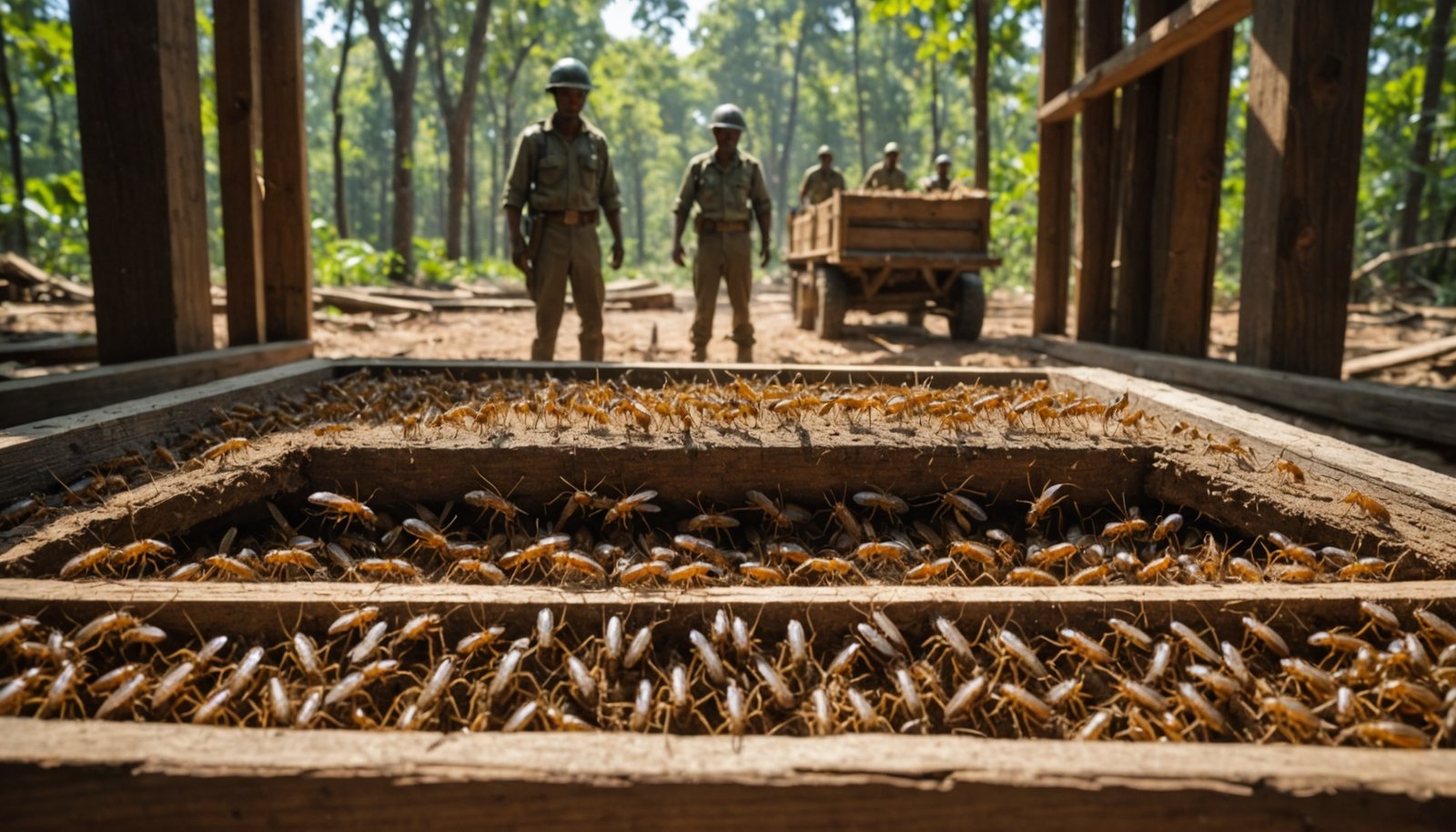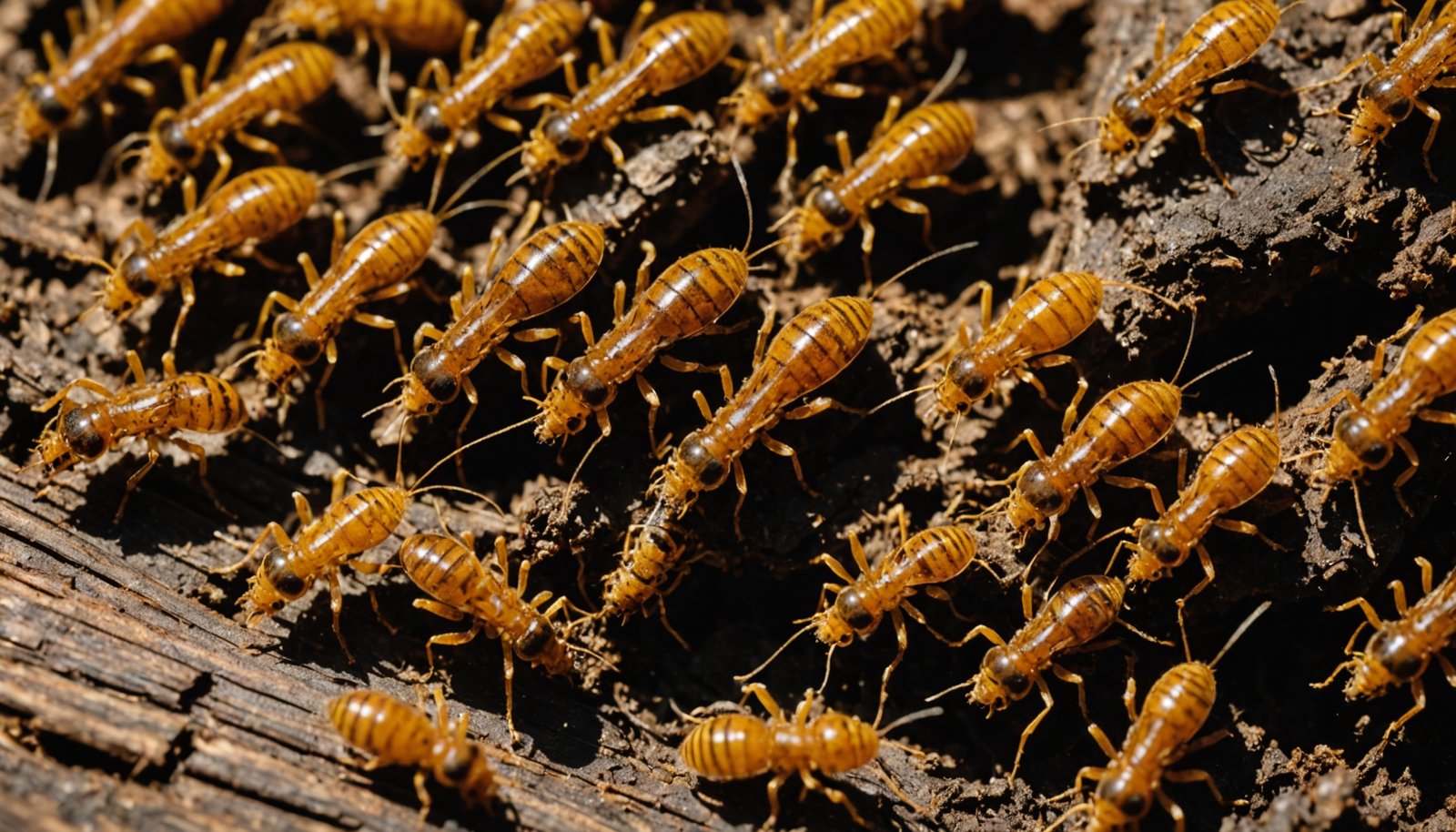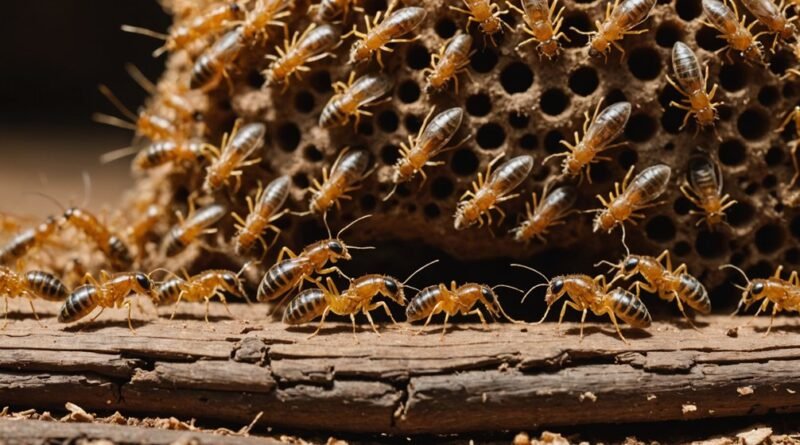Termite Soldiers Vs Workers: What Each Role Means for Your Home
When you spot termites in your home, you’ll notice two distinct types: pale workers and darker orange soldiers. Workers pose the main threat, as they’re the ones actively consuming wood and creating tunnels through your property. Soldiers defend the colony with powerful mandibles but can’t feed themselves. While both types work together to maintain the colony, understanding their unique roles will help you better protect your property from devastating damage.
Key Takeaways
- Workers are the main wood-consuming threat, capable of destroying a foot-long section of lumber within five months.
- Soldiers protect the colony but can’t feed themselves, making worker termites the primary targets for effective pest control.
- Workers maintain and expand colony tunnels through your home, while soldiers guard these pathways against threats.
- Worker termites comprise most of the colony population and are responsible for all construction damage to wooden structures.
- Spotting pale, creamy-white workers indicates active infestation, while orange soldiers suggest established colonies requiring immediate treatment.
Physical Differences Between Soldier and Worker Termites

When examining a termite colony, you’ll notice striking physical differences between soldiers and workers. While workers have pale, creamy-white bodies, soldiers display darker orange coloration. You’ll immediately spot soldiers by their larger size and prominent heads, which are distinctly harder than those of workers.
The most distinctive feature you’ll see is the soldiers’ powerful mandibles, developed specifically for defense, compared to the workers’ smaller, saw-toothed jaws used for construction and maintenance. The soldiers’ rigid exoskeleton provides extra protection during defensive duties.
Termite soldiers wield powerful mandibles for colony defense, while workers possess smaller jaws perfectly suited for building and repairs.
Both castes share basic insect features like six legs and straight antennae, but soldiers often have additional defensive structures, including a frontal gland and nasus for secreting protective substances.
Despite their fierce appearance, soldiers can’t feed themselves and depend entirely on workers for survival.
The Daily Tasks of Worker Termites in Your Home

Your home’s worker termites spend their days tirelessly consuming wood and creating extensive tunnel networks throughout the structure.
These industrious insects maintain and expand their colony by building intricate nests, ensuring proper temperature control, and constantly repairing damaged areas.
Worker termites use their strong mandibles to break down cellulose materials and create passages within wooden structures.
They’ll also distribute food to other colony members through a process called trophallaxis, storing nutrients in specialized chambers within their network of tunnels.
Wood Consumption and Tunneling
The relentless appetite of worker termites poses a severe threat to homes across America, with a single colony of 60,000 capable of consuming a foot-long section of lumber in just five months.
Your home’s wooden structures are particularly vulnerable when these destructive pests find ideal conditions of warmth and moisture.
Worker termites create elaborate networks of tunnels through your home’s wooden components, often remaining undetected until significant damage has occurred.
You’ll notice their presence through telltale signs like bubbling paint, hollow-sounding wood, or musty odors.
They’re especially drawn to baseboards, fence posts, and firewood piles, where they construct mud tubes connecting their underground nests to these wood sources.
Left unchecked, their constant feeding can compromise your home’s structural integrity, leading to sagging floors and foundation issues. With colonies taking three to five years to mature, damage often remains hidden until it becomes severe.
Nesting and Colony Growth
Inside your home’s walls, worker termites perform an intricate ballet of daily tasks that keep their colonies thriving and expanding. These tireless insects work around the clock, maintaining perfect nest conditions by regulating temperature and moisture levels.
They’ll construct and repair tunnels while removing waste to prevent disease outbreaks within the colony. Worker termites appear as pale-white insects with rounded heads as they carry out their duties.
You won’t see these workers nurturing the colony’s future, but they’re constantly feeding and grooming eggs, nymphs, and the queen through a process called trophallaxis.
They support the colony’s growth by tending to immature termites and ensuring proper molting conditions. As temperatures rise above 70°F, their activity intensifies, leading to faster colony expansion.
They’ll adapt their behaviors to seasonal changes, maintaining steady colony development regardless of environmental challenges.
Food Distribution and Storage
Within your walls, worker termites maintain a complex food distribution network that keeps every colony member fed and thriving.
These tireless insects travel up to 300 feet to find cellulose-rich materials, leaving chemical trails for others to follow. They’re the only termites equipped with special gut bacteria to digest wood and paper.
What makes workers particularly efficient is their role as the colony’s food processors and distributors. To avoid dehydration and predators, they move through enclosed tunnel systems while transporting food.
They’ll partially digest the cellulose before sharing it mouth-to-mouth with other termites, including soldiers who can’t feed themselves. They also store food reserves underground and incorporate cellulose particles into nest structures for later use.
About 20% of workers focus on food gathering at any time, ensuring your home’s wood becomes a constant food supply for the growing colony.
How Soldier Termites Protect the Colony

Soldier termites stand ready to defend your home’s colony using an impressive arsenal of defensive weapons and tactics.
You’ll find these blind warriors using their powerful mandibles to crush, slash, and snap at invaders while also employing chemical signals to alert the entire colony of threats.
Through their specialized heads and toxic secretions, soldier termites create an effective security system that protects workers and reproductives from ants and other predators.
Defense Tactics and Methods
While termite colonies face numerous threats from predators, their defense system relies on an impressive arsenal of tactics deployed by specialized soldier termites. You’ll find these defenders using high-speed mandible attacks to bite and kill intruders, particularly targeting vulnerable areas like antennae and legs.
| Defense Method | Soldier Termites | Worker Termites |
|---|---|---|
| Primary Response | Direct combat engagement | Fleeing and hiding |
| Physical Weapons | Large mandibles, plug-like heads | None |
| Communication | Head-banging vibrations, pheromones | Basic chemical signals |
Soldiers patrol your home’s nest perimeters constantly, staying ready to fight rather than flee. They’ll use head-banging to create vibrations that alert others to danger, while releasing defensive pheromones through their mandibles. Though blind, they effectively detect threats through tactile and chemical signals, coordinating with workers to protect the entire colony.
Colony Security Strategies
As termite colonies face constant threats, their sophisticated security system integrates multiple layers of defense. Soldier termites serve as the primary security force, using their specialized morphology and chemical weapons to protect the colony.
They’ll position themselves at vital entry points, ready to snap their powerful mandibles or spray chemical secretions at invaders.
You’ll find these soldiers working in perfect sync with worker termites, who provide essential support by feeding them and maintaining the colony’s infrastructure.
Workers also play an important role in the alarm system, quickly alerting soldiers to threats through chemical signals and vibrations.
Together, they’ve developed an effective strategy where soldiers guard the tunnels and galleries while workers fortify the structures, creating a robust defense against predators, particularly ants.
Key Warning Signs of Termite Activity
Identifying early signs of termite activity can mean the difference between minor repairs and catastrophic structural damage.
You’ll want to regularly inspect your home for key warning signs that indicate these destructive pests have moved in. Watch for mud tubes along your foundation, discarded wings near windowsills, and wood that sounds hollow when tapped.
If you notice doors or windows becoming stuck, or see paint bubbling on your walls, you may have an active infestation.
- Frass (termite droppings) appearing as small, uniform pellets near wooden surfaces
- Visible tunneling in wood with a rough, carved appearance
- Swarming termites, especially in spring or after rain
- Musty odors combined with warped or sagging wooden structures
- Blistering in laminate flooring or baseboards
Understanding Colony Dynamics and Structure
To understand how termites operate, you’ll need to grasp their complex social structure and colony dynamics.
Every colony starts with a king and queen who mate continuously to produce eggs. As the colony grows, distinct castes emerge: workers, soldiers, and reproductives, each with specialized roles.
Workers form the majority, handling all labor from construction to caregiving, while soldiers focus solely on colony defense.
You’ll find the queen in a central chamber, laying up to 1,000 eggs daily in mature colonies, with workers attending to her needs.
The colony communicates through chemical signals and physical contact, coordinating activities like foraging and defense.
When colonies mature after 2-4 years, they’ll produce winged reproductives that swarm to establish new colonies elsewhere.
Prevention and Control Strategies for Homeowners
While termites pose a serious threat to homes, several effective prevention and control strategies can protect your property. You’ll need a multi-layered approach combining chemical treatments, physical barriers, and ongoing maintenance.
Protecting your home from termites requires a comprehensive defense strategy, utilizing multiple proven methods to ensure lasting protection.
Chemical soil treatments create protective barriers around your foundation, while bait stations gradually eliminate colonies. You can also treat wood directly and maintain proper structural conditions to make your home less appealing to termites.
- Install chemical barriers through trenching, costing $500-$2,000 depending on property size
- Set up bait stations with slow-acting toxins for colony elimination ($1,000-$2,500)
- Maintain an 18-inch gap between soil and wood surfaces
- Seal cracks and treat exposed wood with appropriate sealants
- Conduct regular inspections and remove cellulose sources near your home
Conclusion
When you’re dealing with termites, knowing the difference between soldiers and workers helps you identify and tackle infestations early. You’ll spot workers more often since they’re the ones causing damage, while soldiers defend these destructive activities. Don’t wait to see both types – if you notice any termite signs, contact a pest control professional immediately to protect your home’s structure.

